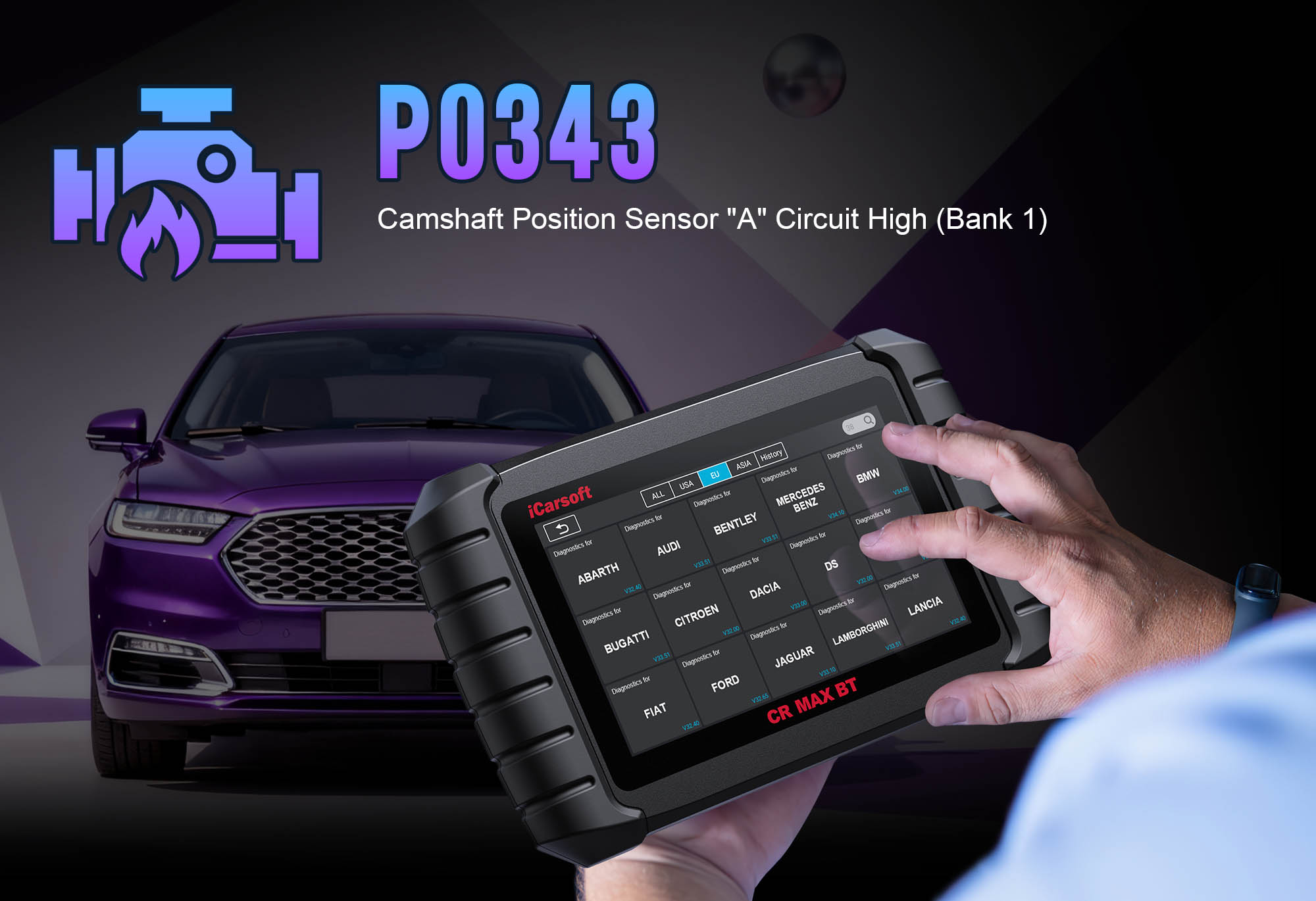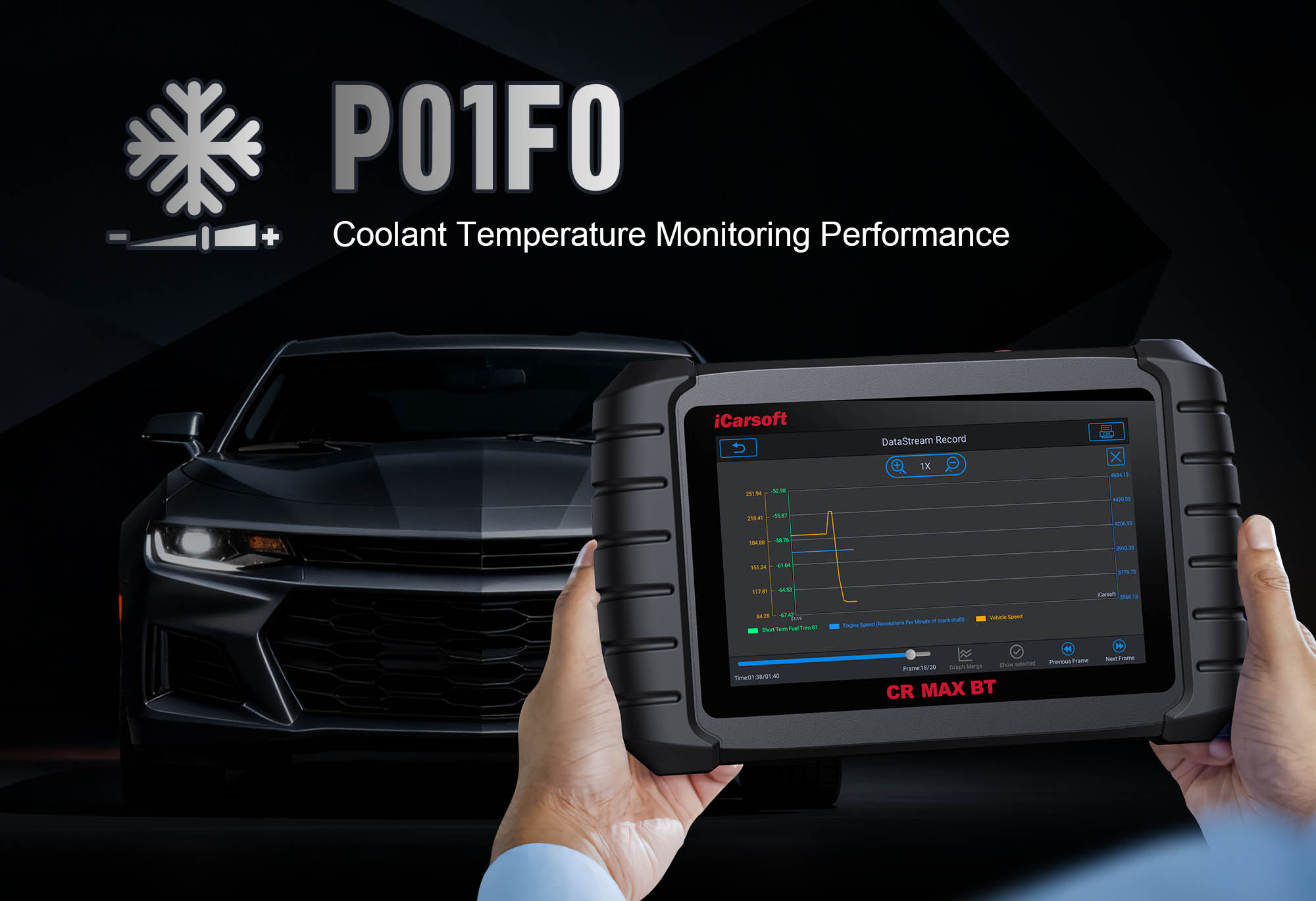Understand & Fix P0343: Camshaft Position Sensor A Circuit High Voltage with iCarsoft CR MAX BT
If your vehicle’s Check Engine Light (CEL) flashes, the engine misfires, or it struggles to start—especially in wet or cold weather—a diagnostic scan will likely return P0343. This critical OBD-II code indicates "Camshaft Position Sensor A Circuit High Voltage," meaning the Engine Control Module (ECM) is receiving an abnormally high voltage signal (typically above 4.5V) from the primary camshaft position sensor (Sensor A). Ignoring P0343 can lead to severe engine damage, complete stalling, and failed emissions tests—making prompt diagnosis and repair essential.
Basic code readers can only confirm "P0343 is present" but can’t distinguish between a faulty sensor, damaged wiring, or an ECM malfunction—often resulting in expensive part swaps that don’t fix the issue. The iCarsoft CR MAX BT changes the game. As a professional-grade diagnostic tool, it offers wireless OE-level testing, real-time signal tracking, and compatibility with 58+ vehicle brands, making it the ideal solution for resolving P0343 in popular models like the Ford F-150, Chevrolet Silverado, and Toyota Camry. Let’s break down everything you need to fix P0343 with confidence.
 iCarsoft CR MAX BT monitoring camshaft sensor voltage to diagnose P0343
iCarsoft CR MAX BT monitoring camshaft sensor voltage to diagnose P0343
What Exactly Is the P0343 Code?
P0343 targets the camshaft position sensor A—the primary sensor responsible for monitoring the camshaft’s rotation and relaying that data to the ECM. This sensor works with the crankshaft position sensor to sync fuel injection and ignition timing, ensuring smooth engine operation. Normally, the sensor sends a voltage signal between 0.5V and 4.5V to the ECM; when this signal exceeds 4.5V consistently, the ECM logs P0343.
The "A" in P0343 refers to the sensor associated with the #1 cylinder’s camshaft (often the intake camshaft in dual-cam engines). While the code is generic, its trigger can vary by make—for example, Ford F-150 P0343 often stems from wiring issues, while Toyota Camry P0343 may link to sensor heat damage. The iCarsoft CR MAX BT uses Auto VIN technology to pull vehicle-specific specs, eliminating generic guesswork and pinpointing the root cause fast.
Key Symptoms of the P0343 Code
P0343 disrupts critical engine timing, so symptoms are usually noticeable and worsen over time. Watch for these red flags:
-
Illuminated/Flashing Check Engine Light: The primary warning sign. A flashing CEL indicates severe misfiring—stop driving immediately to avoid catalyst damage (common in Chevrolet Silverado P0343).
-
Engine Misfires or Rough Idling: Incorrect timing causes unburned fuel in the cylinders, leading to shaking, sputtering, or uneven idle (especially noticeable in low gears).
-
Hard Starting or No-Start Condition: The ECM can’t sync ignition without accurate camshaft data, making the engine crank repeatedly without turning over—critical for cold-weather P0343 cases.
-
Reduced Power & Acceleration: The engine may hesitate, bog down, or refuse to reach higher RPMs, as the ECM limits performance to prevent damage.
-
Increased Fuel Consumption & Emissions: Misfires and incorrect timing waste fuel and raise hydrocarbon levels, leading to failed smog checks (a major concern for California P0343 compliance).
Common Causes of the P0343 Code
P0343 stems from issues in the camshaft sensor or its electrical circuit. Here are the most likely culprits, ordered by frequency:
|
Cause
|
Description
|
|
Damaged Camshaft Position Sensor
|
Internal component failure (from heat, oil contamination, or vibration) causes the sensor to send erratic high-voltage signals. Top cause in high-mileage P0343 vehicles (100,000+ miles).
|
|
Wiring or Connector Issues
|
Frayed wires, corroded terminals, or loose connectors create resistance, leading to voltage spikes. Common in Ford F-150 P0343 (exposed underhood wiring prone to damage).
|
|
Short Circuit to Battery Voltage
|
A sensor wire touching the vehicle’s 12V battery circuit forces the signal to exceed 4.5V—often caused by worn insulation.
|
|
ECM Malfunction
|
A faulty ECM may misinterpret normal sensor signals as "high voltage," though this is rare. More often, outdated firmware triggers false P0343 codes.
|
|
Oil Leaks
|
Engine oil seeping into the sensor housing damages internal components—common in Chevrolet Silverado P0343 with camshaft seal leaks.
|
Why iCarsoft CR MAX BT Is Perfect for P0343 Diagnostics
Resolving P0343 requires precise testing of the sensor’s signal, wiring, and ECM communication—something basic scanners can’t handle. The CR MAX BT stands out with features tailored to this fault:
Wireless Bluetooth Diagnostics
Test your vehicle from 30+ feet away—no tangled cables, ideal for accessing hard-to-reach camshaft sensors (e.g., behind timing covers in Toyota Camry).
Real-Time Camshaft Sensor Data
Monitor voltage signals, pulse width, and sync with the crankshaft sensor in text or graph form—spot high-voltage spikes (above 4.5V) in seconds.
Bidirectional Control
Send commands to activate the camshaft sensor and verify its response—eliminates false codes from sensor unresponsiveness.
Auto VIN Identification
Automatically detects your vehicle’s make, model, and sensor location (e.g., intake cam for Ford F-150) for accurate, vehicle-specific diagnostics.
58-Brand Compatibility
Works with all makes prone to P0343, from domestic trucks (Chevrolet Silverado) to import cars (Toyota Camry) and luxury models (Mercedes-Benz).
Circuit Testing Tools
Use built-in continuity and resistance tests to check wiring—pinpoint short circuits or corroded connectors without extra tools.
Step-by-Step: Diagnose & Fix P0343 with iCarsoft CR MAX BT
-
1. Confirm P0343 & Gather Vehicle-Specific Data
1. Plug the CR MAX BT’s OBD-II adapter into your vehicle’s port and pair it via Bluetooth (the 7-inch touchscreen connects in under 10 seconds).
2. Select Auto VIN Identify to pull your vehicle’s specs, then navigate to Engine > Fault Codes > Read Codes to confirm P0343.
3. Tap Code Details for actionable insights—e.g., "Ford F-150: P0343 Camshaft Sensor A High Voltage; Signal: 5.2V; Check Wiring/Sensor."
-
2. Analyze Live Camshaft Sensor Data
Go to Engine > Live Data > Camshaft/Crankshaft Sensors and monitor these key metrics with the engine running (or cranking if it won’t start):
- Camshaft Sensor Voltage: Normal range = 0.5V–4.5V. Consistent readings above 4.5V confirm the P0343 trigger.
- Sensor Sync with Crankshaft: Signals should align (e.g., 1:1 pulse ratio). Mismatched pulses indicate a sensor or timing issue.
- Connector Resistance: Use the Circuit Test function to check sensor wiring—resistance above 5 ohms means corrosion or fraying.
-
3. Test the Sensor & Wiring with Bidirectional Tools
First, locate the camshaft sensor (use the CR MAX BT’s Component Location tool for exact placement).
1. Disconnect its connector and use the tool’s Resistance Test—OEM specs vary (500–1,500 ohms), but infinite resistance means a faulty sensor.
2. For wiring tests: Use the Continuity Test to check wires between the sensor and ECM. A "no continuity" result means a broken wire; a "short to battery" result (12V reading) confirms a short circuit—repair with heat-shrink tubing or replace the harness.
-
4. Repair & Validate the Fix
Replace the faulty camshaft sensor (use OEM parts for compatibility) or repair wiring. For ECM firmware issues, use the CR MAX BT’s One-Key Upgrade to install the latest update.
1. Clear P0343 via Fault Codes > Clear Codes, then test drive for 50–100 miles to ensure the code doesn’t return.
2. Re-scan with the CR MAX BT—stable voltage (0.5V–4.5V) and synced camshaft/crankshaft signals confirm the issue is resolved.
FAQs: Your P0343 Questions Answered
Q: Is it safe to drive with the P0343 code?
A: No—especially if the CEL is flashing. P0343 causes misfires that can destroy the catalytic converter (costing $800–$2,000) and lead to engine stalling. Drive only to a repair shop if necessary.
Q: How much does it cost to fix P0343?
A: A camshaft sensor replacement costs $150–$300 (parts + labor), while wiring repairs are $80–$150. The CR MAX BT saves $100+ on diagnostic fees by pinpointing the issue upfront—avoiding unnecessary sensor swaps.
Q: Why does P0343 keep coming back after sensor replacement?
A: You likely missed a hidden issue: corroded wiring, a short circuit, or outdated ECM firmware. Use the CR MAX BT’s circuit tests and software updates to resolve these root causes.
Q: Does P0343 affect both gasoline and diesel engines?
A: Yes—P0343 is common in diesel trucks (e.g., Chevrolet Silverado Duramax) and gasoline cars alike. The CR MAX BT’s diesel-specific diagnostics handle high-pressure fuel system timing for diesel models.
Q: Can weather cause P0343?
A: Absolutely—moisture (rain, snow) can corrode sensor connectors, leading to voltage spikes. The CR MAX BT’s Connector Test function detects moisture-related resistance issues.
Q: Will P0343 cause me to fail an emissions test?
A: Yes—misfires from incorrect timing raise hydrocarbon and CO2 levels. Fix P0343 with the CR MAX BT to ensure compliance, even in strict states like California.
Conclusion
The P0343 code’s high-voltage camshaft sensor issue is a serious concern, but misdiagnosing it doesn’t have to be. The iCarsoft CR MAX BT takes the guesswork out with wireless testing, real-time data, and vehicle-specific insights—whether you’re fixing a Ford F-150, Chevrolet Silverado, or Toyota Camry.
Don’t let P0343 damage your engine or drain your wallet. Invest in the CR MAX BT today to diagnose, fix, and prevent camshaft sensor issues with professional-grade confidence.

 iCarsoft CR MAX BT monitoring camshaft sensor voltage to diagnose P0343
iCarsoft CR MAX BT monitoring camshaft sensor voltage to diagnose P0343


